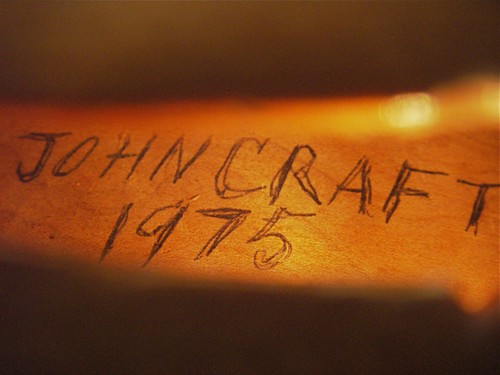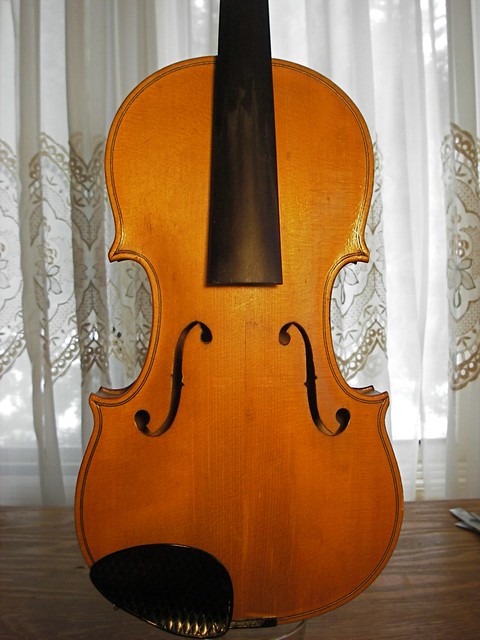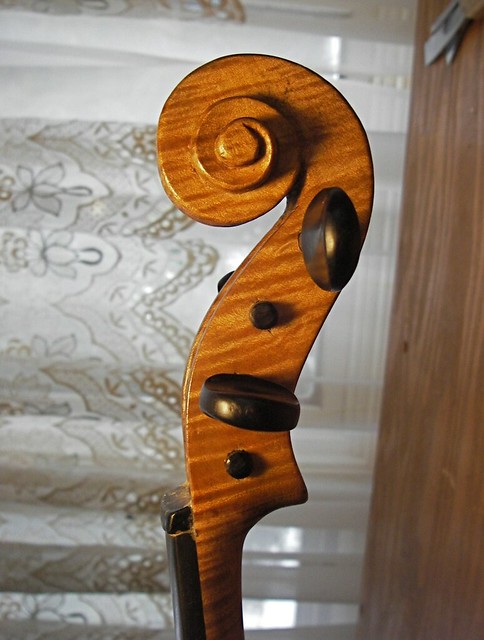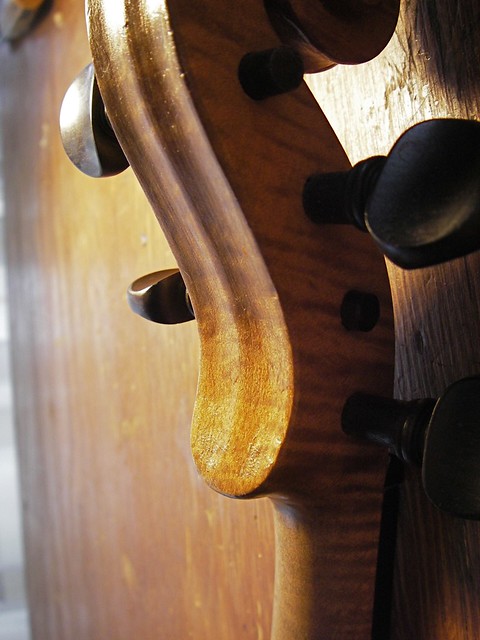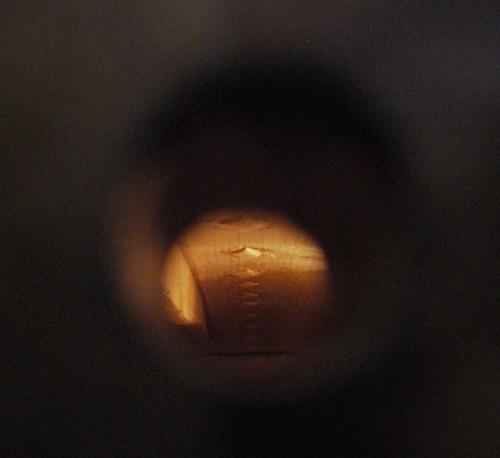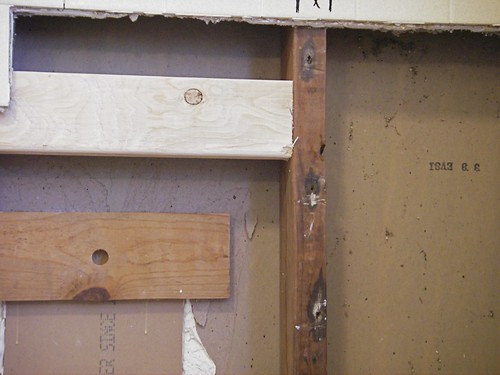Thursday, January 24, 2013
Jim Brown, Violinmaker in Claremont, California.
Jim Brown is the organizer of the Southern California Violin Makers Workshop, which is taught by Michael Darnton. Jim is the fellow who puts everything together, and is even the fellow who picks us students up as we come in to the airport, one-by-one, scattered throughout the day.
Here's a nice 8-minute video on Jim and his own shop.
Breathing Life.
And one of my photos of Jim giving a varnish demo at the 2008 workshop.
Monday, January 14, 2013
John Craft 1975 violin
John Craft was a local maker, local being Nampa, Idaho. This instrument came in for a little repair and set-up work. Here's his 'label' seen through the f-hole.
In spite of some of their eccentricities, violins made back in out-of-the-way places before much information was readily available interest me. I never met John Craft, but I do hear stories of him.
The front of the instrument, showing the general outline. Black-white-black purfling, somewhat pinched corners.
The back was really astounding. A very dynamic finish, it changed readily with the view angle. Here are two shots at different light angles.
The pegbox was somewhat oversized, larger and bulkier than normal. Poorly fit pegs shown here were replaced and the nut was cleaned up. It was too high and had gobs of glue extending out all sides. I don't know whether this was the original set-up or if it had been redone at some time.
Curves of the scroll are a bit clunky. Considering that in 1975 Nampa he probably didn't have much to model it on -- no Internet, no Strad magazine posters -- you do what you do.
The fluting was quite shallow, particularly on the back, with the center ridge nearly disappearing at the heel of the pegbox.
The top seam appeared somewhat open from the outside, though solid. Looking in through the endpin, we could see many diamond-shaped cleats.
Sunday, January 13, 2013
The Color of Age in Wood, part 2
One of my Flickr contacts commented on my photos, posted in this blog yesterday, mentioning the rust marks in the old 2x4s, something she thought might not be pertinent to violins. Her argument that (1) a bathroom wall was periodically very humid, and (2) it contained nails -- unlike violins.
Well, it reminded me of a couple things that many violin makers know, but which might not be common knowledge among normal, non-violin-obsessed folk.
First, the violin (and the viola) actually is subjected to fairly humid conditions. The player is breathing right on top of the instrument, with moist air from the player's nose sending moisture over the top and in the f-holes. I am an amateur fiddler. Our band played a contra dance last night, and as the fiddler, I get quite a work-out. The dance lasts about 2-1/2 hours, and though I'm not playing the entire time, I do probably get a good 45 minutes to an hour of fast playing.
If you watch videos of the really great players, you can often see that they are putting out a lot of energy. And that's just the performance. Imagine the thousands of hours that go into practice.
So that's humidity.
Now about nails. Modern violins are not made with nails. But in the time of the Amati, Guarneri, and Stradivari, they were. The necks were not mortised into the neck block as they are now. They were surface mounted -- a butt joint -- to the ribs, and nailed from behind (drilled first, no doubt) and the plates were installed afterwards. This method is not as strong, in part due to the differential tensions in the strings. Necks could be pulled to the e-string side over time or fail altogether. The neck mortise solved this problem, and nearly all old instruments have had their necks reset, with the addition of wood to make up the difference.
From the National Music Museum at the University of South Dakota, an x-ray of the neck of a tenor viola built by Andrea Guarneri in 1664.
And from a 1693 Stradivari violin, the rust stains from similar nails that have bled out to the surface.
In the Stradivari neck heel, you can also see an extra piece of wood, just above the ebony crown, indicating a neck reset. That is, that slice of wood was added by a later repair person when working on the instrument. The ebony crown is a later addition as well, being put in place to clean up damage done to the button in, say, a neck reset.
You can see the rest of the Guarneri viola here and the rest of the Stradivari violin here.
Some violin makers might try to simulate this sort of aging and some players might look for it because it has the 'right' appearance.
Well, it reminded me of a couple things that many violin makers know, but which might not be common knowledge among normal, non-violin-obsessed folk.
First, the violin (and the viola) actually is subjected to fairly humid conditions. The player is breathing right on top of the instrument, with moist air from the player's nose sending moisture over the top and in the f-holes. I am an amateur fiddler. Our band played a contra dance last night, and as the fiddler, I get quite a work-out. The dance lasts about 2-1/2 hours, and though I'm not playing the entire time, I do probably get a good 45 minutes to an hour of fast playing.
If you watch videos of the really great players, you can often see that they are putting out a lot of energy. And that's just the performance. Imagine the thousands of hours that go into practice.
So that's humidity.
Now about nails. Modern violins are not made with nails. But in the time of the Amati, Guarneri, and Stradivari, they were. The necks were not mortised into the neck block as they are now. They were surface mounted -- a butt joint -- to the ribs, and nailed from behind (drilled first, no doubt) and the plates were installed afterwards. This method is not as strong, in part due to the differential tensions in the strings. Necks could be pulled to the e-string side over time or fail altogether. The neck mortise solved this problem, and nearly all old instruments have had their necks reset, with the addition of wood to make up the difference.
From the National Music Museum at the University of South Dakota, an x-ray of the neck of a tenor viola built by Andrea Guarneri in 1664.
And from a 1693 Stradivari violin, the rust stains from similar nails that have bled out to the surface.
In the Stradivari neck heel, you can also see an extra piece of wood, just above the ebony crown, indicating a neck reset. That is, that slice of wood was added by a later repair person when working on the instrument. The ebony crown is a later addition as well, being put in place to clean up damage done to the button in, say, a neck reset.
You can see the rest of the Guarneri viola here and the rest of the Stradivari violin here.
Some violin makers might try to simulate this sort of aging and some players might look for it because it has the 'right' appearance.
Saturday, January 12, 2013
The Color of Age in Wood
Doing a little bathroom repair, and noticed today something that might apply to violin making, in particular, the antiquing process. Here we have three pieces of wood, probably similar in color originally. Probably similar wood, fir of some sort. Similar to the spruce top of a violin.
The vertical stud is from the 1950s, and most likely has not been exposed to sunlight for much time. The vertical wood on the lower end is from a repair I did about 10 years ago, from the other side of the wall. It's backing for a sheetrock repair. The wood probably had seen some sunlight and was most likely just stuff I had around the shop. The vertical wood at top is new material, bought at the lumber store the other day. Photo taken with no flash, sunlight in the window and incandescent in the room.
Same as above, but with the camera flash on.
The vertical stud is from the 1950s, and most likely has not been exposed to sunlight for much time. The vertical wood on the lower end is from a repair I did about 10 years ago, from the other side of the wall. It's backing for a sheetrock repair. The wood probably had seen some sunlight and was most likely just stuff I had around the shop. The vertical wood at top is new material, bought at the lumber store the other day. Photo taken with no flash, sunlight in the window and incandescent in the room.
Same as above, but with the camera flash on.
Friday, January 11, 2013
Bright idea -- well, 40 watts, which for me is bright.
A non-fiddle-making post, but you have to eat, too.
It’s only taken me, what, a couple decades or so to figure it out......
I use a long rise in my bread making, 24 hours or so. One problem I’ve had is finding a place that is consistently warm over that time period. We turn the heat off at night, and in the winter, it can be 60 degrees F or lower in the kitchen by morning.
Some folks have suggested a warming box -- a box dedicated to keeping the rising dough warm. Simple enough thing. Basically a box and a heat source, such as an incandescent bulb. But I really don’t like kitchen gadgets, those bulky things that are dedicated to a single use, a non-every-day use. Not a solution I’d like.
I’ve also heard of folks using their oven for a warming box. Oven not on, but the light is. The idea being the light provides enough heat. I’ve tried that, and my oven light is not warm enough.
So I decided to buy a light socket, one of those ceramic or plastic fixtures folks use in their utility rooms. Wire a cord on it, with a plug. Attach the base to a short section of 2x4, and I have something I could put in the oven, running the cord out (door closed) and plugged in. I’d have to store the socket-and-board somewhere, but it’s much smaller than a box.
When I got to the hardware store, I found the little socket shown in the photo. About $2. Exactly what I wanted, but didn't know it existed. A 40W bulb and an extension cord complete the concept. Used it last night, and it’s just right. And when I’m done with it, it goes back into a drawer.
My go-to bread recipe is the no-knead version from Jim Lahey's book. You can find a recipe on the New York Times site.
Wednesday, January 2, 2013
Michael Darnton (violin maker) in the News
I've attended the Southern California Violin Makers Workshop every June since 2008. Although the workshop runs for 3 weeks each June, I can only attend for one, occasionally two weeks, each year. I have a frequent conflict with the last week of the workshop as it coincides with the National Old Time Fiddlers Contest in Weiser, Idaho, where we set up shop to tend to instruments and sell a few.
Michael Darnton teaches the Violin Makers Workshop. He's a careful teacher, precise, and probably gets tired of telling me the same thing repeatedly. Eventually, however, I do learn something, so on to the next feature of making. It's also a great opportunity to meet with other makers, see their instruments, and occasionally see some really fine, old Italian fiddles.
Michael was featured recently in his local (Chicago) newspaper. Here's a video clip from that interview (newspaper as in the 21st century sense).
Violin-maker demonstrates his handmade process.
And here is a link to a scanned pdf of the print version.
Endeavor of guesswork.
It's really great for me to see Michael in action, hear his voice, be reminded of this or that part of making.
I also have my own photos from the workshop, links on the year.
2008
2009
2010
2011
2012
Subscribe to:
Posts (Atom)


